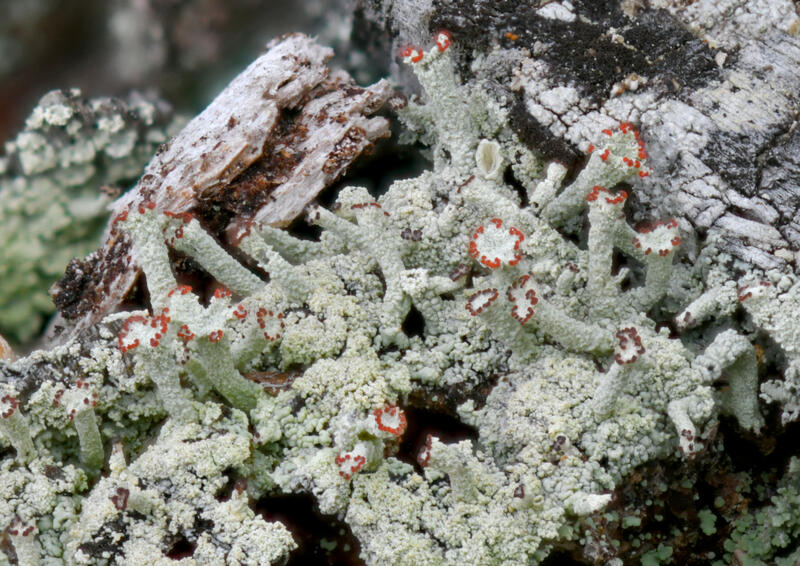







Loading profile. Please wait . . .
Cladonia ravenelii Tuck.
Little Pine Soldiers




Federal Protection: No US federal protection
State Protection: No Georgia state protection
Global Rank: G2G4
State Rank: SNR
Element Locations Tracked in Biotics: No
SWAP 2015 Species of Greatest Conservation Need (SGCN): No
SWAP 2025 Species of Greatest Conservation Need (SGCN): No
2025 SGCN Priority Tier: None
Element Occurrences (EOs) in Georgia: 0
Habitat Summary for element in Georgia: Upland and bottomland forests and woodlands with pine component
Pale blue-green primary thallus (though soredia can appear yellow-green when wet), sometimes minute & scale-like, usually revolute, with some forming linear lobules (as in photo), though more commonly sorediate, with a variably maculate upper surface; larger squamules can form in bark cracks or in low-light situations, up to 1 mm long, appearing more feathery and loosely sorediate; podetia variable (often absent), 1-5 mm long, usually lumpy but corticate, simple to multi-branched, occasionally with patches of soredia, tipped with red apothecia or pycnicia, both of which can blacken (with age?); sterile thalli can be told by the small, revolute, bluish sorediate squamules; CHEMISTRY: K+ bright yellow (thamnolic acid); FIELD ID: unmistakable, especially if fertile; shape & color of squamules usually enough on sterile thalli, with experience
See accounts for Cladonia cristatella, C. abbreviatula, C. hypoxantha, C. incrassata; can be confused with Lepraria harrisiana if sterile thalli dissolve into sorediate masses, but the Lepraria is neater & bluer
None
Upland & bottomland forests & woodlands with pine component; substrates: over 80% of records on Pinus, mostly bark, but also wood, detritus & cones; also found on Juniperus bark & wood, hardwood bark, Taxodium bark, & soil
Corticolous squamulose/fruticose lichenized fungus, photobiont a chlorococcoid alga in genus Trebouxia or Pseudotrebouxia
None
Statewide
Unknown
Common to abundant status in Ga., where it is likely undersurveyed because small, usually sterile & often growing low on tree; species does not seem to deserve such a low G-rank, at least here
None
Brodo, I. M. 2001. Lichens of North America. Yale University Press, New Haven, Conn.
Brodo, I. M. 2016. Keys to lichens of North America: revised and expanded. Yale University Press, New Haven, Conn.
Esslinger, T. L. 2021. A cumulative checklist for the lichen-forming, lichenicolous and allied fungi of the continental United States and Canada. Version 24. Opuscula Philolichenum 20: 100-394.
Harris, R. C. 1995. More Florida lichens including the 10-cent tour of the pyrenolichens. Unpublished manuscript, Bronx, N.Y.
Malcolm Hodges
13 May 2022